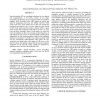Free Online Productivity Tools
i2Speak
i2Symbol
i2OCR
iTex2Img
iWeb2Print
iWeb2Shot
i2Type
iPdf2Split
iPdf2Merge
i2Bopomofo
i2Arabic
i2Style
i2Image
i2PDF
iLatex2Rtf
Sci2ools
ICASSP
2011
IEEE
2011
IEEE
Why word error rate is not a good metric for speech recognizer training for the speech translation task?
Speech translation (ST) is an enabling technology for cross-lingual oral communication. A ST system consists of two major components: an automatic speech recognizer (ASR) and a machine translator (MT). Nowadays, most ASR systems are trained and tuned by minimizing word error rate (WER). However, WER counts word errors at the surface level. It does not consider the contextual and syntactic roles of a word, which are often critical for MT. In the end-to-end ST scenarios, whether WER is a good metric for the ASR component of the full ST system is an open issue and lacks systematic studies. In this paper, we report our recent investigation on this issue, focusing on the interactions of ASR and MT in a ST system. We show that BLEU-oriented global optimization of ASR system parameters improves the translation
Cross-lingual Oral Communication | ICASSP 2011 | Signal Processing | Word Error Rate | Word Errors |
| Added | 21 Aug 2011 |
| Updated | 21 Aug 2011 |
| Type | Journal |
| Year | 2011 |
| Where | ICASSP |
| Authors | Xiaodong He, Li Deng, Alex Acero |
Comments (0)

